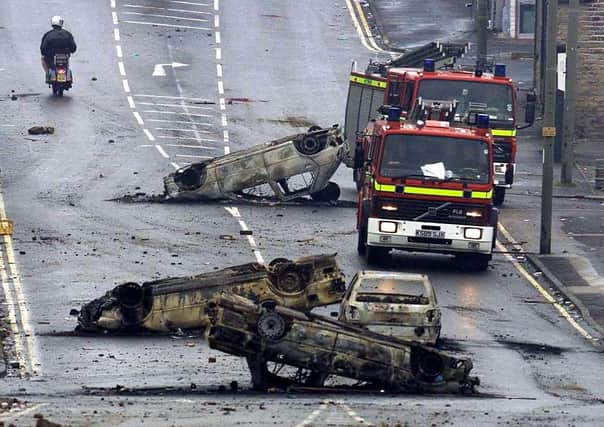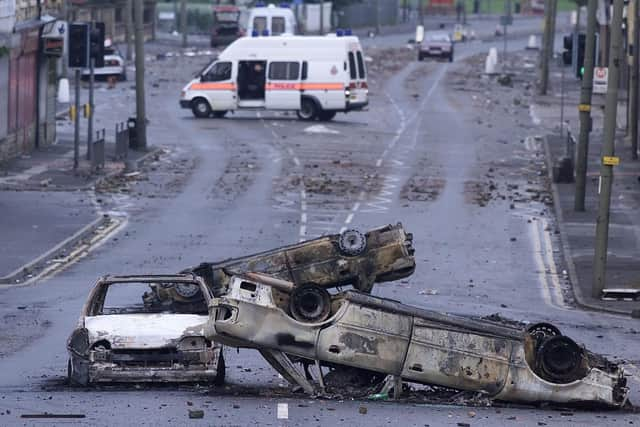20 years on, what did we learn from Bradford riots?


The battle lines in Bradford had been drawn early in the day. It was in Centenary Square, around Saturday lunchtime, that 500 or so supporters of the Anti-Nazi League picked up their placards for a mass rally. As they gathered, a rumour spread that people sympathetic to the National Front had convened in a pub around the corner.
Neither side had left the location to chance. There had already been riots in Burnley and Oldham that early summer of 20 years ago, but Bradford was seen as the epicentre of discontent.
Advertisement
Hide AdAdvertisement
Hide AdOutside the pub, as the right-wing rabble shouted abuse, Asian youths began fighting them, and as the violence escalated out of control, one of their number was stabbed. By nightfall whole pockets of the city were aflame.


The riots of 2001 were quite different to those of two decades before, in which disenfranchised white and Afro-Caribbean communities had taken to the streets in cities across Britain. This time, the bitterness had a distinctly Northern flavour.
On the nights of July 8 and 9, some 1,000 youths were caught up in the violence. At least as many police, most of them in full riot gear, responded. Shops, businesses and the city’s main BMW garage were targeted and destroyed. The Manningham Labour Club, with 23 people inside, was firebombed.
By then the National Front supporters were nowhere to be seen, as a councillor pointed out at the time. “There’s no logic to this,” said Mohammed Riaz, accusing the rioters of “setting Bradford back 10 years” with little justification. “Where is the protest, where is the National Front?” he asked.
When the dust settled, there was damage estimated at £27m.
Advertisement
Hide AdAdvertisement
Hide AdThe right-wingers had wanted to stage a march through Bradford but David Blunkett, the Home Secretary, banned it. Within the city, the belief was that outsiders had sensed a powder keg and had travelled there to orchestrate the violence.
It was not the first time Bradford’s Asian areas had erupted. Disturbances across the Manningham district in June 1995 had highlighted the segregated nature of the city’s run-down inner suburbs. But the destruction of 2001 was on a different level. More than 300 police were injured and almost as many people were arrested.
“Bradford was seen as a bit of a one-off,” said Professor Brendan Evans, of Huddersfield University. “It had the highest number of residents of south Asian heritage residents and it was an obvious place for the National Front and other far right groups to want to demonstrate.”
But he added: “The Anti-Nazi League were not entirely virtuous. They had Socialist Workers Party and other ultra-left activists who saw the opportunity to try and create havoc, disruption and confrontation between the two groups.”
Advertisement
Hide AdAdvertisement
Hide AdThe immediate aftermath was a report by Lord Ouseley, former chairman of the Commission for Racial Equality, who portrayed Bradford as living “in the grip of fear” of crime. But two months after the riots, the political balance changed again with the September 11 attacks on New York and Washington DC.
“It could be that white communities became less tolerant of Asian people or it could be that Asian communities became more militant afterwards,” said Prof Evans.
“There was some tacit support for Asian militancy and terror activities amongst some young Asian people, but equally there was much more hostility towards Muslims amongst the white community.”
“It may be that a consequence of the riots was to solidify the Asian community,” he added. “But there is no room for complacency.”
Advertisement
Hide AdAdvertisement
Hide AdThe 2001 riots in Bradford constituted Britain’s worst mainland violence in 20 years.
Some 200 people were locked up for their part in the mayhem. Two years on, the Court of Appeal rejected a claim that the sentences, ranging mostly from four to five years, failed to take into account the “matrix of fear” created by the National Front. Mr Blunkett, said simply that those jailed for their part in the riots should stop “whining”.
Six years after the dust settled, a 33-year-old man became the 200th person to be locked up, after work colleagues identified him from video footage of the violence.
Support The Yorkshire Post and become a subscriber today. Your subscription will help us to continue to bring quality news to the people of Yorkshire. In return, you’ll see fewer ads on site, get free access to our app and receive exclusive members-only offers. Click here to subscribe.
Comment Guidelines
National World encourages reader discussion on our stories. User feedback, insights and back-and-forth exchanges add a rich layer of context to reporting. Please review our Community Guidelines before commenting.